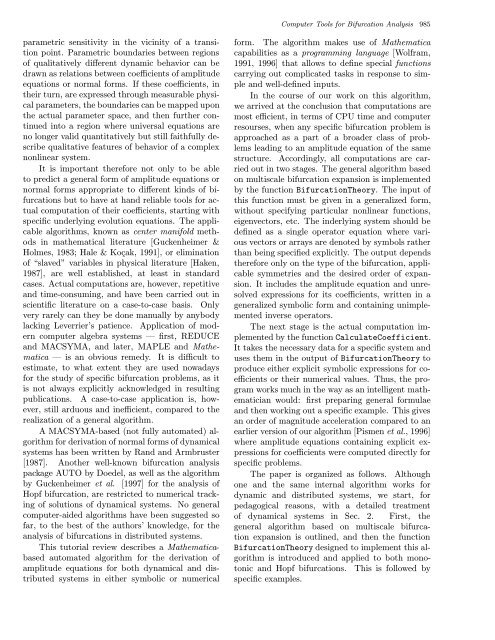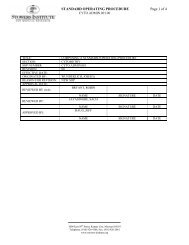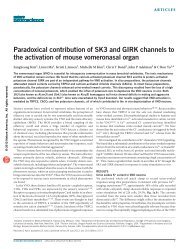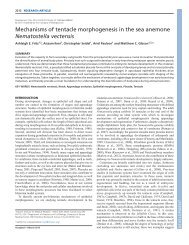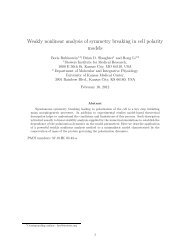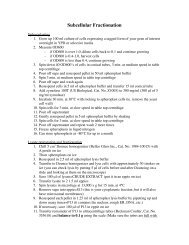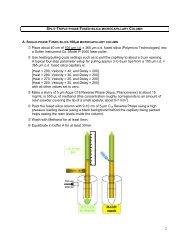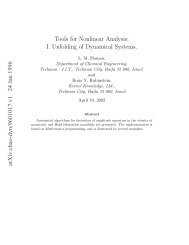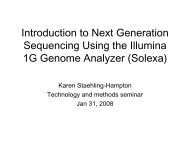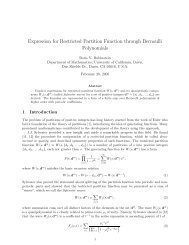Computer Tools for Bifurcation Analysis: General Approach with
Computer Tools for Bifurcation Analysis: General Approach with
Computer Tools for Bifurcation Analysis: General Approach with
Create successful ePaper yourself
Turn your PDF publications into a flip-book with our unique Google optimized e-Paper software.
<strong>Computer</strong> <strong>Tools</strong> <strong>for</strong> <strong>Bifurcation</strong> <strong>Analysis</strong> 985<br />
parametric sensitivity in the vicinity of a transition<br />
point. Parametric boundaries between regions<br />
of qualitatively different dynamic behavior can be<br />
drawn as relations between coefficients of amplitude<br />
equations or normal <strong>for</strong>ms. If these coefficients, in<br />
their turn, are expressed through measurable physical<br />
parameters, the boundaries can be mapped upon<br />
the actual parameter space, and then further continued<br />
into a region where universal equations are<br />
no longer valid quantitatively but still faithfully describe<br />
qualitative features of behavior of a complex<br />
nonlinear system.<br />
It is important there<strong>for</strong>e not only to be able<br />
to predict a general <strong>for</strong>m of amplitude equations or<br />
normal <strong>for</strong>ms appropriate to different kinds of bifurcations<br />
but to have at hand reliable tools <strong>for</strong> actual<br />
computation of their coefficients, starting <strong>with</strong><br />
specific underlying evolution equations. The applicable<br />
algorithms, known as center manifold methods<br />
in mathematical literature [Guckenheimer &<br />
Holmes, 1983; Hale & Koçak, 1991], or elimination<br />
of “slaved” variables in physical literature [Haken,<br />
1987], are well established, at least in standard<br />
cases. Actual computations are, however, repetitive<br />
and time-consuming, and have been carried out in<br />
scientific literature on a case-to-case basis. Only<br />
very rarely can they be done manually by anybody<br />
lacking Leverrier’s patience. Application of modern<br />
computer algebra systems — first, REDUCE<br />
and MACSYMA, and later, MAPLE and Mathematica<br />
— is an obvious remedy. It is difficult to<br />
estimate, to what extent they are used nowadays<br />
<strong>for</strong> the study of specific bifurcation problems, as it<br />
is not always explicitly acknowledged in resulting<br />
publications. A case-to-case application is, however,<br />
still arduous and inefficient, compared to the<br />
realization of a general algorithm.<br />
A MACSYMA-based (not fully automated) algorithm<br />
<strong>for</strong> derivation of normal <strong>for</strong>ms of dynamical<br />
systems has been written by Rand and Armbruster<br />
[1987]. Another well-known bifurcation analysis<br />
package AUTO by Doedel, as well as the algorithm<br />
by Guckenheimer et al. [1997] <strong>for</strong> the analysis of<br />
Hopf bifurcation, are restricted to numerical tracking<br />
of solutions of dynamical systems. No general<br />
computer-aided algorithms have been suggested so<br />
far, to the best of the authors’ knowledge, <strong>for</strong> the<br />
analysis of bifurcations in distributed systems.<br />
This tutorial review describes a Mathematicabased<br />
automated algorithm <strong>for</strong> the derivation of<br />
amplitude equations <strong>for</strong> both dynamical and distributed<br />
systems in either symbolic or numerical<br />
<strong>for</strong>m. The algorithm makes use of Mathematica<br />
capabilities as a programming language [Wolfram,<br />
1991, 1996] that allows to define special functions<br />
carrying out complicated tasks in response to simple<br />
and well-defined inputs.<br />
In the course of our work on this algorithm,<br />
we arrived at the conclusion that computations are<br />
most efficient, in terms of CPU time and computer<br />
resourses, when any specific bifurcation problem is<br />
approached as a part of a broader class of problems<br />
leading to an amplitude equation of the same<br />
structure. Accordingly, all computations are carried<br />
out in two stages. The general algorithm based<br />
on multiscale bifurcation expansion is implemented<br />
by the function <strong>Bifurcation</strong>Theory. The input of<br />
this function must be given in a generalized <strong>for</strong>m,<br />
<strong>with</strong>out specifying particular nonlinear functions,<br />
eigenvectors, etc. The inderlying system should be<br />
defined as a single operator equation where various<br />
vectors or arrays are denoted by symbols rather<br />
than being specified explicitly. The output depends<br />
there<strong>for</strong>e only on the type of the bifurcation, applicable<br />
symmetries and the desired order of expansion.<br />
It includes the amplitude equation and unresolved<br />
expressions <strong>for</strong> its coefficients, written in a<br />
generalized symbolic <strong>for</strong>m and containing unimplemented<br />
inverse operators.<br />
The next stage is the actual computation implemented<br />
by the function CalculateCoefficient.<br />
It takes the necessary data <strong>for</strong> a specific system and<br />
uses them in the output of <strong>Bifurcation</strong>Theory to<br />
produce either explicit symbolic expressions <strong>for</strong> coefficients<br />
or their numerical values. Thus, the program<br />
works much in the way as an intelligent mathematician<br />
would: first preparing general <strong>for</strong>mulae<br />
and then working out a specific example. This gives<br />
an order of magnitude acceleration compared to an<br />
earlier version of our algorithm [Pismen et al., 1996]<br />
where amplitude equations containing explicit expressions<br />
<strong>for</strong> coefficients were computed directly <strong>for</strong><br />
specific problems.<br />
The paper is organized as follows. Although<br />
one and the same internal algorithm works <strong>for</strong><br />
dynamic and distributed systems, we start, <strong>for</strong><br />
pedagogical reasons, <strong>with</strong> a detailed treatment<br />
of dynamical systems in Sec. 2. First, the<br />
general algorithm based on multiscale bifurcation<br />
expansion is outlined, and then the function<br />
<strong>Bifurcation</strong>Theory designed to implement this algorithm<br />
is introduced and applied to both monotonic<br />
and Hopf bifurcations. This is followed by<br />
specific examples.


